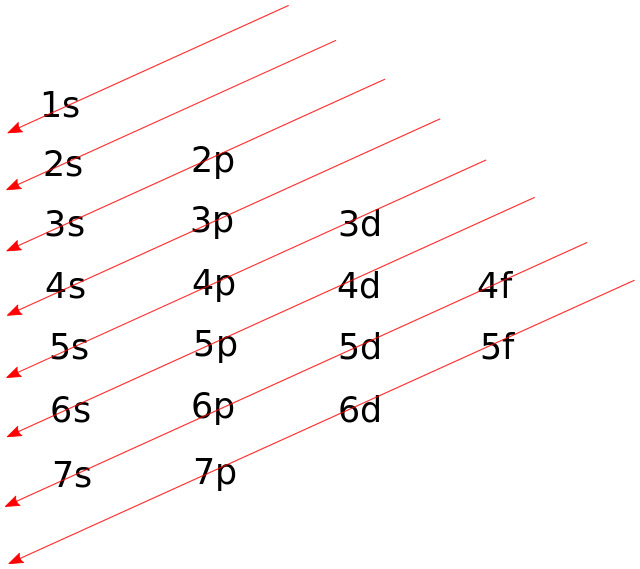
Elements up to atomic number 112 have been discovered till now. What will be the electronic configuration of the element possessing atomic number 108.
A) $[Rn]5{f^{14}}6{d^6}7{s^2}$
B) $6{f^{14}}7{d^8}7{s^2}$
C) $[Rn]5{f^{14}}6{d^6}7{s^0}$
D) $[Xe]4{f^{14}}5{d^8}6{s^2}$
Answer
382.2k+ views
Hint: To find the electronic configuration we will have to know about the Aufbau Principle. To find out the condensed electron configuration, the configuration of the nearest Noble gas is considered followed by filling the remaining electrons into the shells.
Complete answer:
The Aufbau principle was named after the word ‘Aufbeen’. According to this principle the electrons are filled according to the energies of the orbitals, meaning that the orbitals with lower energies are filled first and then the higher energy one’s are filled. The energy of an orbital can be determined as the sum of principle and the azimuthal quantum numbers of that orbital. According to this, the order in which the electrons are filled in the orbitals is: 1s, 2s, 2p, 3s, 3p, 4s, 3d, 4p, 5s, 4d, 5p, 6s, 4f, 5d, 6p, 7s, 5f, 6d, 7p…
The order can be conveniently represented by the image below:

We have to find the electronic configuration of an element having atomic number 108. Hence, we can say that the element contains 108 electrons. First we’ll find the nearest Noble gas to this atomic number, which is Radon (At. No = 86). The condensed molecular formula can be written wrt to the Radon atom. The electronic configuration of Radon is: $[Xe]4{f^{14}}5{d^{10}}6{s^2}6{p^6}$
The difference in the no. of electrons between Radon and given element is: $108 - 86 = 22$
Hence in the condensed formula we’ll have to add 22 electrons after Radon. From the Aufbau Principle the orbital filling after 6p is 7s. After that 5f,6d will be filled. The final electronic configuration of given element is: $E.C = [Rn]7{s^2}5{f^{14}}6{d^6}$
The correct answer is Option (A).
Note:
The given element belongs to the d-block as the last electron enters the d shell. The group no. of a d-block element can be given as: $no.of{\text{ }}electron\operatorname{s} {\text{ }}in{\text{ }}(n - 1)d{\text{ }}shell + no.of{\text{ }}electron\operatorname{s} {\text{ }}in{\text{ }}s{\text{ }}subshell$
The group no. of the given element $ = 4 + 2 = 6$
Complete answer:
The Aufbau principle was named after the word ‘Aufbeen’. According to this principle the electrons are filled according to the energies of the orbitals, meaning that the orbitals with lower energies are filled first and then the higher energy one’s are filled. The energy of an orbital can be determined as the sum of principle and the azimuthal quantum numbers of that orbital. According to this, the order in which the electrons are filled in the orbitals is: 1s, 2s, 2p, 3s, 3p, 4s, 3d, 4p, 5s, 4d, 5p, 6s, 4f, 5d, 6p, 7s, 5f, 6d, 7p…
The order can be conveniently represented by the image below:

We have to find the electronic configuration of an element having atomic number 108. Hence, we can say that the element contains 108 electrons. First we’ll find the nearest Noble gas to this atomic number, which is Radon (At. No = 86). The condensed molecular formula can be written wrt to the Radon atom. The electronic configuration of Radon is: $[Xe]4{f^{14}}5{d^{10}}6{s^2}6{p^6}$
The difference in the no. of electrons between Radon and given element is: $108 - 86 = 22$
Hence in the condensed formula we’ll have to add 22 electrons after Radon. From the Aufbau Principle the orbital filling after 6p is 7s. After that 5f,6d will be filled. The final electronic configuration of given element is: $E.C = [Rn]7{s^2}5{f^{14}}6{d^6}$
The correct answer is Option (A).
Note:
The given element belongs to the d-block as the last electron enters the d shell. The group no. of a d-block element can be given as: $no.of{\text{ }}electron\operatorname{s} {\text{ }}in{\text{ }}(n - 1)d{\text{ }}shell + no.of{\text{ }}electron\operatorname{s} {\text{ }}in{\text{ }}s{\text{ }}subshell$
The group no. of the given element $ = 4 + 2 = 6$
Recently Updated Pages
Using the following information to help you answer class 12 chemistry CBSE

Full Form of IASDMIPSIFSIRSPOLICE class 7 social science CBSE

In case of conflict between fundamental rights of citizens class 7 social science CBSE

Can anyone list 10 advantages and disadvantages of friction

What are the Components of Financial System?

Complete the letter given below written to your Principal class null english null

Trending doubts
Show variation of resistivity of copper as a function class 12 physics CBSE

Electrolysis of dilute H2SO4 generates H2S2O8 What class 12 chemistry CBSE

Explain with a neat labelled diagram the TS of mammalian class 12 biology CBSE

How do you convert from joules to electron volts class 12 physics CBSE

A convex lens is placed in water Its focal length A class 12 physics CBSE

Distinguish between asexual and sexual reproduction class 12 biology CBSE




